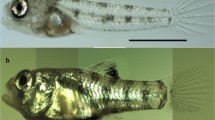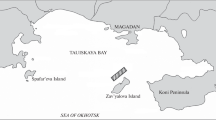Abstract
The bivalve osphradium is a band of putatively sensory tissue located in the gill axis, whose function is uncertain. In the present study, extending from 1987 to 1994, anatomical, histological, and electron microscopical techniques were used to elucidate the structure and ultrastructure of the osphradium in hatchery Pecten maximus L. and Placopecten magellanicus (Gmelin) (collected from Passamaquoddy Bay, New Brunswick, Canada). The osphradium consists of two distinct regions which run longitudinally on both sides of each gill axis: the osphradial ridge, and the dorsal tuft cilia region. The osphradial ridge was largely devoid of cilia other than those of the few free nerve fibres. The dorsal tuft cilia region contained free nerve fibres and ciliary tufts, separated by undifferentiated epithelial cells. No paddle cilia were observed under isosmotic fixation conditions, although under hypotonic conditions such cilia were quite common, suggesting an artefactual nature. Most of the cells of the osphradial ridge were highly secretory, the principal products being large pigment granules (in Pecten maximus) directly secreted by the Golgi bodies, and numerous small, electron-dense vesicles. These vesicles were arranged along extensive microtubule arrays in the basal region, indicative of axonal transport. These data support and extend Haszprunar's hypothesis of the role of the osphradium in the reception of chemical spawning cues and in the synchronization of gamete emission. Together with independent data on nerve pathways, osphradial sensory modalities, and monoamine localisation, an anatomical pathway and neurophysiological mediator are postulated.
Similar content being viewed by others
References
Adiyodi KG, Adiyodi RG (1989) (eds) Reproductive biology of invertebrates, Vol. IV, Part A. Fertilization, development and parental care. John Wiley and Sons, Chichester
Adiyodi KG, Adiyodi RG (1990) (eds) Reproductive biology of invertebrates, Vol. IV, Part B. Fertilization, development and parental care. John Wiley and Sons, Chichester
Andrews JD (1979) Pelecypoda: Ostreidae. In: Giese AC, Pearse JS (eds) Reproduction of marine invertebrates, Vol 5. Academic Press, New York, pp 293–341
Bailey DF, Benjamin PR (1968). Anatomical and electrophysiological studies on the gastropod osphradium. Symp zool Soc Lond 23:263–268
Beninger PG (1987) A qualitative and quantitative study of the reproductive cycle of the giant scallop Placopecten magellanicus in the Bay of Fundy (New Brunswick, Canada). Can J Zool 65:495–498
Beninger PG, Le Pennec M (1991) Functional anatomy of scallops. In: Shumway SE (ed) Scallops: biology, ecology and aquaculture. Elsevier, Amsterdam, pp 132–223
Beninger PG, Potter T, St-Jean S (1995) Paddle cilia fixation artefacts in pallial organs of adult Mytilus edulis and Placopecten magellanicus. Can J Zool (in press)
Boer HH, Douma E, Koksma JMA (1968) Electron microscope study of neurosecretory cells and neurohaemal organs in the pond snail Lymnaea stagnalis. Symp zool Soc Lond 22:237–256
Bonga SEW (1970) Ultrastructure and histochemistry of neurosecretory cells and neurohaemal areas in the pond snail Lymnaea stagnalis (L.). Z Zellforsch 108:190–224
Coggeshall RE (1967) Light and electron microscope study of the abdominal ganglion of Aplysia californica. J Neurophysiol 30: 1263–1287
Crisp MC (1971) Structure and abundance of receptors of the unspecialized external epithelium of Nassarius reticulatus (Gastropoda, Prosobranchia). J mar biol Ass UK 51: 865–890
Dakin WG (1909) Pecten. Liverpool marine biology Committee Memoirs No. 17, Liverpool
Dakin WG (1910) The visceral ganglion of Pecten, with some notes on the physiology of the nervous system, and an inquiry into the innervation of the osphradium in Lamellibranchia. Mitt zool stn Neapel 20: 1–40
Deiner M, Tamm S (1991) Mechanism of paddle cilia formation in molluscan veligers. Biol Bull mar biol Lab, Woods Hole 181: 335
Deiner M, Tamm SL, Tamm S (1993) Mechanical properties of ciliary axonemes and membranes as shown by paddle cilia. J Cell Sci 104:1251–1262
Dorsett DA (1986) Brains to cells: the neuroanatomy of selected gastropod species. In: Willows AOD (ed) The Mollusca, Vol 9. Neurobiology and behavior, Part 2. Academic Presss, Orlando, pp 101–187
Drew GA (1906) The habits, anatomy, and embryology of the giant scallop (Pecten tenuicostatus, Mighels). Univ Maine Studies Ser, No 6, Orono
Gibbons MC, Castagna M (1984) Serotonin as an inducer of spawning in six bivalve species. Aquaculture, Amsterdam 40: 189–191
Gibbons MC, Goodsell JG, Castagna M, Lutz RA (1983) Chemical induction of spawning by serotonin in the ocean quahog Arctica islandica (Linné). J Shellfish Res 3: 203–205
Haszprunar G (1985a) The fine morphology of the osphradial sense organs of the Mollusca. I. Gastropoda, Prosobranchia. Phil Trans R Soc Lond (Ser B) 307: 457–496
Haszprunar G (1985b) The fine morphology of the osphradial sense organs of the Mollusca. II. Allogastropoda (Architertonicidae, Pyramidellidae). Phil Trans R Soc Lond (Ser B) 307: 497–505
Haszprunar G (1987a) The fine morphology of the osphradial sense organs of the Mollusca. III. Placophora and Bivalvia. Phil Trans R Soc Lond (Ser B) 315: 37–61
Haszprunar G (1987b) The fine morphology of the osphradial sense organs of the Mollusca. IV. Caudofoveata and Solenogastres. Phil Trans R Soc Lond (Ser B) 315: 63–73
Haszprunar G (1992) Ultrastructure of the osphradium of the Tertiary relict snail, Campanile symbolium Iredale (Mollusca, Streptoneura). Phil Trans R Soc Lond (Ser B) 337: 457–460
Humason GL (1979) Animal tissue techniques, (4th edn). WH Freeman, San Francisco
Kessel RG, Kardon RH (1979) Tissues and organs: a text-atlas of scanning electron microscopy. W.H. Freeman Co., New York
Kraemer LR (1981) The osphradial complex of two freshwater bivalves: histological evaluation and functional context. Malacologia 20: 205–216
Laverack MS (1968) On the receptors of marine invertebrates. Oceanogr mar biol A Rev 6: 249–324
Laverack MS (1988) The diversity of chemoreceptors. In: Atema JL, Fay RR, Popper AN, Tavolga WN (eds) Sensory biology of aquatic animals. Springer-Verlag, New York, pp 287–312
Mackie GL (1984) Bivalves: In: Tompa AS, Verdonk AH, Van Den Bigellar (eds) The Mollusca, Vol 7: Reproduction. Academic Press, San Diego, pp 376–377
Matsutani T, Nomura T (1982) Induction of spawning by serotonin in the scallop, Patinopecten yessoensis (Jay). Mar Biol Lett 3: 353–358
Paulet YM, Donval A, Bekhadra F (1993) Monoamines and reproduction in Pecten maximus, a preliminary approach. Invert Reprod Dev 23: 89–94
Sastry AN (1979) Pelecypods (excluding Ostreidae). In: Giese AC, Pearse JS (eds) Reproduction of marine invertebrates, Vol 5. Academic Press, New York, pp 113–292
Schroer TA, Kelly RB (1985) In vitro translocation of organelles along microtubules. Cell 40: 729–730
Setna SB (1930) Neuro-muscular mechanism of the gill of Pecten. Q Jl microsc Sci 73: 365–391
Short G, Tamm S (1989) Paddle cilia occur as artifacts in veliger larvae of Spisula solidissima and Lyrodes pedicellatus. Biol Bull mar biol Lab, Woods Hole 177: 314
Short G, Tamm SL (1991) On the nature of paddle cilia and discocilia. Biol Bull mar biol Lab, Woods Hole 180: 466–474
Sokolov VA, Zaitseva OV (1982) Osphradial chemoreceptors in lamellibranch molluscs, Unio pectorum and Anodonta cygnea. J Evol Biochem Physiol 18: 56–61
Vale RD, Reese TS, Sheetz MP (1985a) Identification of a novel force-generating protein, kinesin, involved in microtubule-based motility. Cell 42: 39–50
Vale RD, Schnapp BJ, Reese TS, Sheetz MP (1985b) Movement of organelles along filaments dissociated from the axoplasm of the squid giant axon. Cell 40: 449–454
Vale RD, Schnapp BJ, Reese TS, Sheetz MP (1985c) Organelle, bead, and microtubule translocations promoted by soluble factors from the squid giant axon. Cell 40: 559–569
Ward JE, Beninger PG, MacDonald BA, Thompson RJ (1991) A new technique for direct observations of feeding structures and mechanisms in bivalve molluscs using endoscopic video examination and video image analysis. Mar Biol 111: 287–291
Yonge CM (1947) The pallial organs in the aspidobranch Gastropoda and their evolution throughout the Mollusca. Phil Trans R Soc Lond (Ser B) 232: 443–518
Author information
Authors and Affiliations
Additional information
Communicated by J.P. Grassle, New Brunswick
Rights and permissions
About this article
Cite this article
Beninger, P.G., Donval, A. & Le Pennec, M. The osphradium in Placopecten magellanicus and Pecten maximus (Bivalvia, Pectinidae): histology, ultrastructure, and implications for spawning synchronisation. Marine Biology 123, 121–129 (1995). https://doi.org/10.1007/BF00350330
Received:
Accepted:
Issue Date:
DOI: https://doi.org/10.1007/BF00350330




